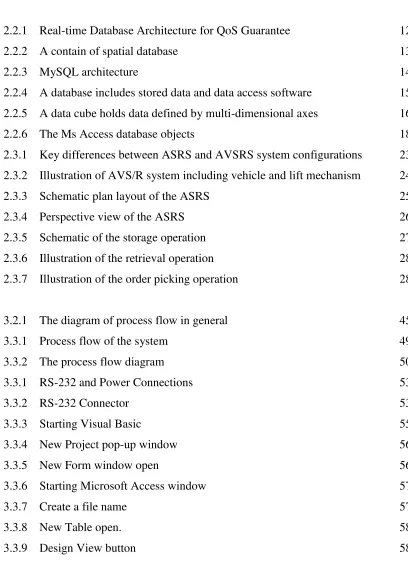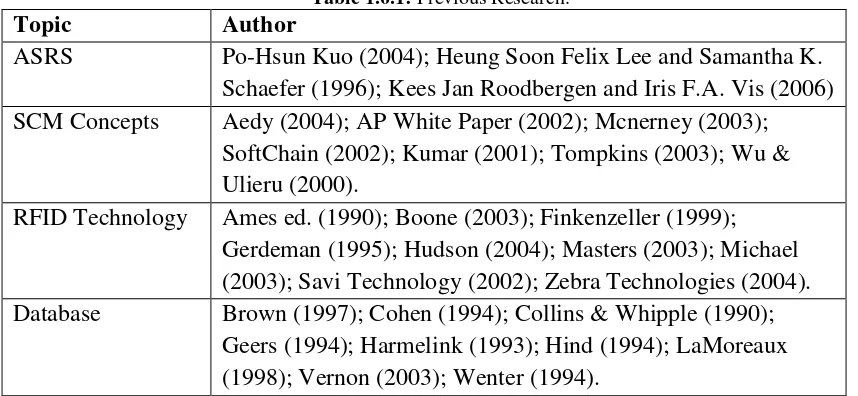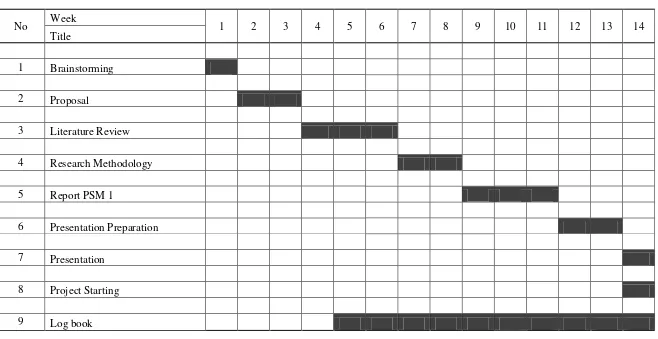UNIVERSITI TEKNIKAL MALAYSIA MELAKA
DEVELOPMENT OF DATABASE SYSTEM FOR AUTOMATED
STORAGE RETRIEVAL SYSTEM USING RFID TECHNOLOGY
This report submitted in accordance with requirement of the Universiti Teknikal Malaysia Melaka (UTeM) for the Bachelor Degree of Manufacturing Engineering
(Robotic and Automation) with Honours
by
SOFIAN BIN ABD SAMAD
i
DECLARATION
I hereby, declared this report entitled “Development of Database System for Automated Storage Retrieval System using RFID Technology” is the results of my own research
except as cited in references.
Signature : ………
Author’s Name : SOFIAN BIN ABD SAMAD
ii
APPROVAL
This report is submitted to the Faculty of Manufacturing Engineering of UTeM as a partial fulfillment of the requirements for the degree of Bachelor of Manufacturing Engineering (Robotic and Automation) with Honours. The member of the supervisory committee is as follow:
(Signature of Supervisor)
………
iii
ABSTRACT
iv
ABSTRAK
v
ACKNOWLEDGEMENT
vi
2.2.1 Introduction and History 11
2.2.2 Studies of Database System 11
2.2.3 Visual Basic.Net 15
vii
2.2.5 Conclusion of Database Review 19
2.3 Automated Storage Retrieval System 20
2.3.1 Introduction and History 20
2.3.2 Studies of Automated Storage Retrieval System 21
2.3.3 Conclusion of ASRS review 29
2.4 Radio Frequency Identification 30
2.4.1 Introduction and History 30
2.4.2 Studies of Radio Frequency Identification 35
2.4.3 Type of Tags 36
2.4.4 Tags Classes 39
2.4.5 ISO Standard 40
2.4.6 Advantages of RFID 41
2.4.7 Disadvantages of RFID 42
2.4.8 Conclusion of RFID review 43
3. METHODOLOGY 44
3.1 Introduction 44
3.2 General Research Strategy 44
3.2.1 Project Research 46
3.2.7 Finalize, Modification and Troubleshoot 47
3.2.8 Testing 47
3.2.9 Report Submit 47
3.2.10 Project Presentation 48
3.3 Specific Research Strategy 48
viii
3.3.2 Database 54
3.3.3 Automated Storage Retrieval System 59
4. DESIGN AND DEVELOPMENT 60
4.1 Introduction 60
4.2 Development of Interface 60
4.3 Development of Database 66
4.4 Development of Hardware 69
4.5 Project Setup 71
4.6 Sequence Process Flow for Overall System 75
5. ANALYSIS, RESULT AND DISCUSSION 77
5.1 Introduction 77
5.2 Distance analysis 77
5.2.1 Result for Distance Analysis 79
5.2.2 Finding of Distance Analysis 81
5.3 Tag Orientation Analysis 82
5.3.1 Result for Orientation Analysis 84
5.3.2 Finding of Orientation Analysis 85
ix A Mechanical Design of RFID Reader B Error Code
C Baud Rate Setting
D The Relation of Frequency and Channel Number E Confidex Manual
x
LIST OF TABLES
1.6.1 Previous Research 6
1.6.2 Gantt Chart PSM 1 8
1.6.3 Gantt Chart PSM 2 9
2.3.1 Solvable special cases of the basic sequencing problem 22 for unit-load ASRS
2.3.2 Methods for dynamic sequencing of unit load ASRS 22
2.4.1 Chronology of RFID 31
2.4.2 The Technical Differences between Active and Passive 38 RFID Technologies
2.4.3 The Functional Capabilities Differences between Active 38 and Passive RFID Technologies
2.4.4 The Tag Classes 40
2.4.5 Defining Air Interface for RFID Devices in ISO/IEC 18000 Series 41
3.3.1 RFID tags specification 51
3.3.2 RFID reader specification 52
5.2.1 Data record for distance analysis 80
5.3.1 The read rate comparison between horizontal and vertical 83
5.3.2 Orientation Analysis result 84
xi
TABLE OF FIGURES
2.2.1 Real-time Database Architecture for QoS Guarantee 12
2.2.2 A contain of spatial database 13
2.2.3 MySQL architecture 14
2.2.4 A database includes stored data and data access software 15 2.2.5 A data cube holds data defined by multi-dimensional axes 16
2.2.6 The Ms Access database objects 18
2.3.1 Key differences between ASRS and AVSRS system configurations 23 2.3.2 Illustration of AVS/R system including vehicle and lift mechanism 24
2.3.3 Schematic plan layout of the ASRS 25
2.3.4 Perspective view of the ASRS 26
2.3.5 Schematic of the storage operation 27
2.3.6 Illustration of the retrieval operation 28
2.3.7 Illustration of the order picking operation 28
3.2.1 The diagram of process flow in general 45
3.3.1 Process flow of the system 49
3.3.2 The process flow diagram 50
3.3.1 RS-232 and Power Connections 53
3.3.2 RS-232 Connector 53
3.3.3 Starting Visual Basic 55
3.3.4 New Project pop-up window 56
3.3.5 New Form window open 56
3.3.6 Starting Microsoft Access window 57
3.3.7 Create a file name 57
3.3.8 New Table open. 58
xii
3.3.10 Data filled 58
3.3.11 An ASRS flow process 59
4.2.1 Origin interface provide from vendor
61
4.2.2 Edited interface with save button 61
4.2.3 Command language for Save button 62
4.2.4 Data captured and stored in text file. 63
4.2.5 Main window for user interface. 63
4.2.6 Command language for Update Out button 64
4.2.7 Command language for Update In button 65
4.2.8 The Category window 66
4.2.9 The Manage Lot window 66
4.3.1 Category table inside database 67
4.3.2 Part master table 67
4.3.3 Lot table 68
4.3.4 Part Transaction table 69
4.4.1 Technical drawing using Solidwork 70
4.4.2 Actual door frame 70
4.5.1 View of complete setup 71
4.5.2 Detail view of Hardware 72
4.5.3 Setting for connection mode and IP address 73
4.5.4 Setting for antenna selection 73
4.5.5 Setting for IP address of computer (host) 74
4.5.6 Observation when the Start button was clicked 75
4.6.1 Process flow for user guiding 76
5.2.1 Condition of system during distance analysis 78
5.2.2 Screenshot for Test 1 79
5.2.3 Graph Reading versus Distance 80
5.3.1 Horizontal condition 82
5.3.2 Vertical condition 82
xiii
5.3.4 Graph Reading Rate versus Test Number 84
5.4.1 Outside view of template box 86
5.4.2 Several views in Position Analysis 87
xiv
LIST OF ABBREVIATIONS
AGV - Automated Guided Vehicle
ASRS - Automated Storage Retrieval System
AVSRS - Automated Vehicle Storage Retrieval System DBMS - Database Management System
FCFS - First Comes First Served
RFID - Radio Frequency Identification SCM - Supply Chain Management SDK - Software Development Kit S/R - Storage/ Retrieval
UHF - Ultra High Frequency
1
CHAPTER 1
INTRODUCTION
This chapter begins with background of storage system in manufacturing. This thesis concerned with the database system and will discuss application of Radio Frequency Identification (RFID) in Automated Storage and Retrieval System (ASRS). Later, the thesis will identify the advantage of RFID in manufacturing sector.
1.1 Background
Groover (2007) stated that the function of storage system is to store material for a period of time and to permit access to those materials when required. Materials stored by manufacturing firms include a variety of types. It categories into three sections with relate directly to the product, relate to the process and relate to overall support of factory operation. The types of storage and methods were dividing into conventional and automated types. In conventional storage, it has four different storage equipments which refer to typical applications. The types are bulky storage, shelves and bins, rack systems and drawer storage. An automated storage system represents a significant investment, and it often requires a new and different way of doing business. It was separated into two general types that are automated storage and retrieval systems and carousel storage systems.
2
older technology that use barcode in ASRS was increased the productivity however by upgrading to RFID which make ASRS become greater efficiency and more facilitate. Groover (2007) acknowledged ASRS is a storage system that performs storage and retrieval operation with speed and accuracy under a defined degree of automation. ASRS consists of rack structure for storing loads and a storage/retrieval mechanism whose motions are linear (x-y-z motions). It also consists of one or more aisle that is each serviced by a storage/retrieval (S/R) machine (the S/R machines are sometimes referred to as cranes). The aisles have storage racks for holding the stored materials. The S/R machines are used to deliver materials to the storage racks and to retrieve materials from the racks. Each ASRS aisle has one or more input/output stations where materials are delivered into the storage system or moved out the system. The input/output stations are called pickup-and-deposit (P&D) stations in ASRS terminology.
In other view, RFID technology can be alternative the used of barcode. RFID can reduce a cost and increase flexibility when it integrated with ASRS. Mark Brown (2007) defines RFID technology belongs to a broader group of technologies known as Auto-Identification (Auto-ID). RFID encompasses technologies that use electromagnetic (radio) waves, part of electromagnetic spectrum, to identify individual items, places, animals or people. RFID can be appropriately implemented for many uses. The most common is to use an identifying number that uniquely identify an object, place, animal or person. The number is stored on an integrated circuit (IC) that is attached to an antenna. Together, the IC and the antenna are called as RFID transponder or tag. The tag is attached to the object, place, animal or person to be identified. A device called interrogator or reader communicates with the tag and is use to read the identifying number from the tag. The reader feeds the number it reads into an information system, which store the number in its database or search it database for the number and returns information stored within about the object, place, animal or person.
3
more than a collection of information that exists over a long period of time, often many years. In common parlance, the term database refers to a collection of data that is managed by a database management system. Molina also quoted a famous paper written by Ted Codd (1970), database systems changed significantly. Codd proposed that database systems should present the user with a view of data organized as tables called relations. Behind the scenes, there might be a complex data structure that allowed rapid response to a variety of queries. Database systems become a major role to this project. The fully utilization of the system will determine success in this project.
1.2 Problem Statement
Productivity becomes the important thing in every manufacturing to survive and compete within each other. Highest request from customer needs the company to prepare and have efficient inventory management system. Today, many multinational manufactures have expensive inventory control such as Automated Storage Retrieval System and Carousel Storage System but they didn’t use the RFID technology to implement at the entrance of storage. They mostly still used barcode as we know the barcode have some weaknesses. Efficient database also plays an important role in a company. Use paper to record is not very appropriate at present. So, database is needed as the correct solution.
1.3 Objective
a. To study and analyze the knowledge of RFID and its application into the storage system
b. To develop a database for storage system.
4
1.4 Scope
Due to the scope of this thesis, there are a number of research limitations. These limitations lead to areas in which further research can be conducted and may be suitable for other thesis. The scope will result in a lack of quantitative data to prove specific findings such as how many companies are using RFID in SCM or exact cost savings realized by corporations. The thesis will not be investigating issues such as society’s privacy concerns. Privacy advocates ensure that privacy related RFID issues remain at the forefront of the industry. The concerns of these groups need reviewing to decipher the extent to which privacy regulations may limit the use of RFID.
1.5 Significance
5
offers a completely new range of applications that vendor claim will lead to improved SCM. While there have been many successful rollouts of RFID technology, few have been related to ASRS. Those applications that have been for SCM purposes have typically been used exclusively for internal organizational purposes such as asset management. There is still reluctance in the business community to invest large amounts of capital in such new technology that is yet to prove itself in the long-term. Compounding this reluctance is the fact that many of these businesses have invested heavily in legacy barcode systems. There is a preference to use a cautious approach, waiting to see what global business leaders do. This is particularly evident in smaller companies, who are delaying announcements regarding the new technology.
1.6 Justification
1.6.1 Previous Research
6
Table 1.6.1: Previous Research.
Topic Author
ASRS Po-Hsun Kuo (2004); Heung Soon Felix Lee and Samantha K. Schaefer (1996); Kees Jan Roodbergen and Iris F.A. Vis (2006) SCM Concepts Aedy (2004); AP White Paper (2002); Mcnerney (2003);
SoftChain (2002); Kumar (2001); Tompkins (2003); Wu & Ulieru (2000).
RFID Technology Ames ed. (1990); Boone (2003); Finkenzeller (1999); Gerdeman (1995); Hudson (2004); Masters (2003); Michael (2003); Savi Technology (2002); Zebra Technologies (2004). Database Brown (1997); Cohen (1994); Collins & Whipple (1990);
Geers (1994); Harmelink (1993); Hind (1994); LaMoreaux (1998); Vernon (2003); Wenter (1994).
1.6.2 The Gap
7
1.7 Project Schedule


